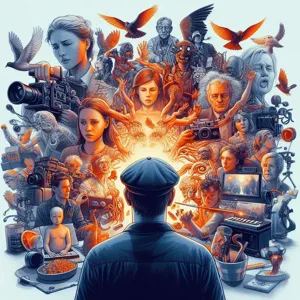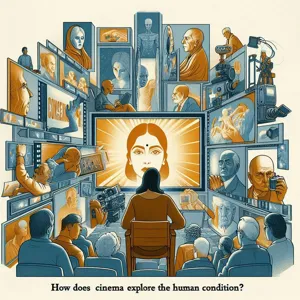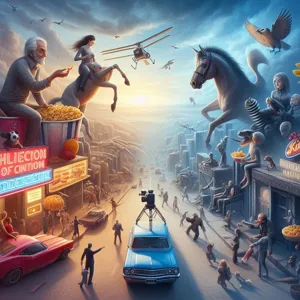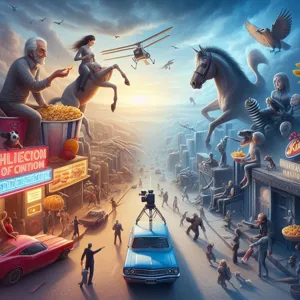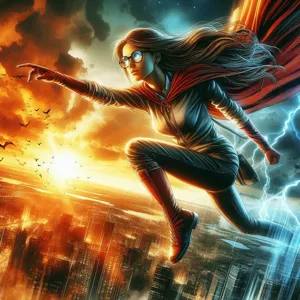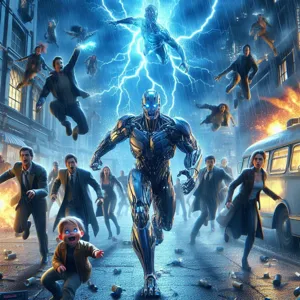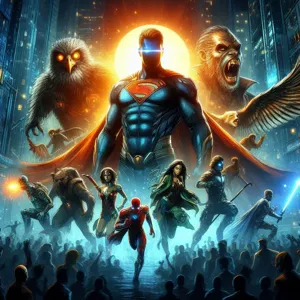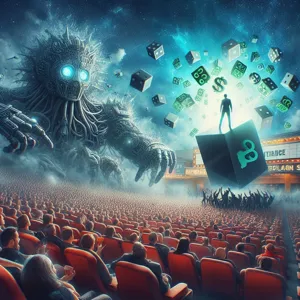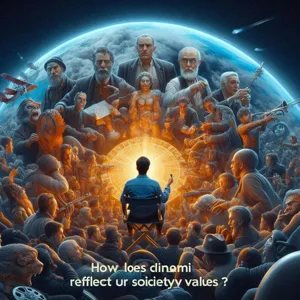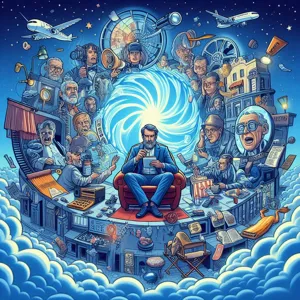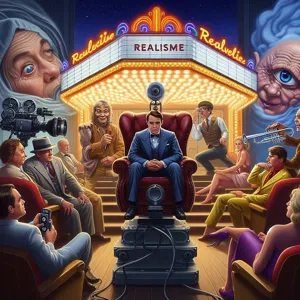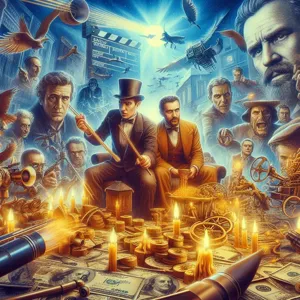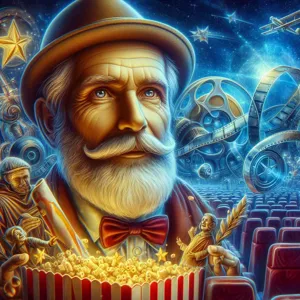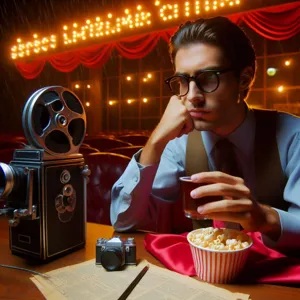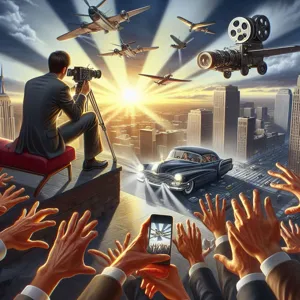Film festivals have long been considered the heartbeat of the cinematic world, serving as a vibrant platform where creativity, culture, and community converge.
From the glitzy red carpets of Cannes to the intimate screenings of Sundance, these events attract filmmakers, actors, critics, and cinephiles alike, all eager to celebrate the art of storytelling through film. However, beneath the glamorous surface lies a complex tapestry of purpose and intention. Are these festivals truly a celebration of cinema, showcasing groundbreaking narratives and emerging talent, or have they devolved into mere extravagant showcases that prioritize spectacle over substance? In this blog post, we will delve into the multifaceted role of film festivals, exploring their impact on the industry, the filmmakers they spotlight, and the audiences they engage, ultimately asking whether they remain a sacred space for artistic expression or have succumbed to the allure of celebrity and commercialism.
1. Introduction: The Evolution of Film Festivals
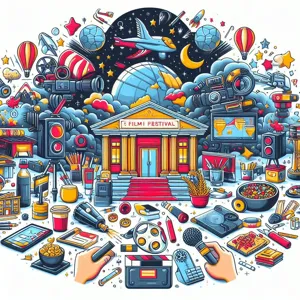
Film festivals have come a long way from their humble beginnings in the early 20th century. Initially conceived as intimate gatherings for filmmakers to showcase their work and connect with audiences, these events have transformed into vibrant spectacles that draw attention from media, industry professionals, and cinephiles alike. The evolution of film festivals reflects not just changes in the film industry, but also shifts in cultural values and societal interests.
In the early days, film festivals were often localized affairs. They served as platforms for independent filmmakers to present their creations to niche audiences, fostering a sense of community and creative exchange. However, as cinema grew in popularity and global reach, so too did the ambitions of these festivals. The Cannes Film Festival, founded in 1946, set the stage for a new era, characterized by red carpets, star-studded galas, and international competition. Today, it stands as a pinnacle of prestige, attracting the world’s most acclaimed directors and actors.
As the landscape of cinema has diversified, so too have film festivals. From the Sundance Film Festival in the United States, which champions independent voices, to the Berlin International Film Festival that blends art with social commentary, each festival has carved out its unique identity. They have become not only venues for film screenings but also platforms for discussion, networking, and even political statements, as filmmakers seize the opportunity to address pressing global issues through their art.
Yet, amidst the glitz and glamour, a pertinent question arises: Are film festivals still about celebrating cinema, or have they devolved into mere extravagant events? The tension between artistic integrity and commercial interests is palpable, as some argue that the emphasis on celebrity culture and marketing overshadow the films themselves. This blog post will delve into this dichotomy, exploring the multifaceted role of film festivals in today’s world—celebrating the art of filmmaking while navigating the complexities of fame and fortune.
2. The Purpose of Film Festivals: Showcasing Talent and Innovation
Film festivals serve as vibrant platforms for showcasing talent and innovation, acting as a vital artery in the lifeblood of the cinema industry. These events are not merely glamorous gatherings filled with red carpets and flashing cameras; they are essential arenas where filmmakers—both emerging and established—can present their work to a diverse audience, including critics, industry professionals, and cinephiles.
At the heart of every film festival lies a commitment to celebrating storytelling in its myriad forms. From thought-provoking documentaries to boundary-pushing experimental films, festivals curate programs that highlight the richness and diversity of global cinema. This curation goes beyond mere entertainment; it is an opportunity to spotlight underrepresented voices, address pressing social issues, and inspire dialogue among viewers.
Moreover, film festivals often provide a springboard for innovation, showcasing cutting-edge techniques and narrative styles that challenge conventional filmmaking. Filmmakers can take risks in this supportive environment, experimenting with new ideas without the constraints typically imposed by mainstream distribution. This spirit of creativity is palpable in the atmosphere of excitement and anticipation that surrounds festival screenings, as audiences eagerly engage with films that push artistic boundaries.
In addition to showcasing films, festivals often incorporate panels, workshops, and networking events, allowing filmmakers to connect with industry leaders, distributors, and potential collaborators. These interactions can lead to invaluable opportunities, from securing funding for future projects to forging partnerships that might otherwise remain out of reach.
Ultimately, the purpose of film festivals transcends entertainment; they are vital cultural events that foster a community of creators and audiences, celebrating the art of cinema while nurturing the next generation of storytellers. As we navigate an ever-evolving cinematic landscape, these festivals remind us of the power of film not just to entertain, but to inspire, provoke thought, and bring people together.
3. The Glamour Factor: Red Carpets and Celebrity Culture

When you think of film festivals, it’s hard not to envision the glitz and glamour that come with them—dazzling red carpets, flashbulb pops from eager photographers, and the magnetic presence of A-list celebrities. The glamour factor is undeniably a significant aspect of film festivals, transforming these events into spectacles that attract media attention and public intrigue.
As stars strut down the red carpet, adorned in designer gowns and sharp tuxedos, they become icons of elegance and style, captivating audiences both in-person and at home. The red carpet itself serves as a stage, showcasing not just the latest films but also the personalities that drive the industry. This blend of cinema and celebrity culture creates an intoxicating atmosphere, where the allure of Hollywood intertwines with the artistry of filmmaking.
However, this glamour is not merely for show; it plays a crucial role in promoting the films and filmmakers involved. Media coverage of these events often focuses more on the fashion and celebrity interactions than on the films themselves, yet this visibility can lead to increased public interest and box office success for the showcased projects. Photographers, journalists, and fans alike flock to capture every moment, ensuring that the films featured are front and center in the public eye.
Yet, there lies a double-edged sword within this glamour. The emphasis on celebrity culture can overshadow the very essence of the festival—the art of cinema itself. Emerging filmmakers and indie productions often struggle to gain recognition in the shadow of big names and high-profile premieres. While the red carpet dazzles, it can inadvertently create a barrier for those outside the Hollywood elite, raising questions about inclusivity and representation in the film industry.
In essence, the glamour factor of film festivals is a powerful tool that elevates cinema into a communal celebration of talent and creativity. However, it also serves as a reminder of the complexities of the industry, where art and celebrity often collide in a vibrant yet sometimes contentious dance. Balancing this glamour with genuine recognition of cinematic achievement is essential to ensure that film festivals remain a true celebration of the medium, honoring the diverse voices and stories that define our cinematic landscape.
4. The Impact of Film Festivals on Independent Filmmakers
Film festivals serve as a pivotal platform for independent filmmakers, offering them not only exposure but also a chance to connect with audiences, industry professionals, and potential investors. These festivals, often celebrated for their glitz and glamour, can sometimes overshadow the crucial opportunities they provide for emerging voices in cinema. Yet, at their core, they are a celebration of creativity and storytelling that can significantly impact the trajectory of independent films.
For many filmmakers, festivals like Sundance, Cannes, and Tribeca are the ultimate launching pads. They provide a unique environment where indie films can shine, often breaking through the noise of mainstream cinema. The selection process itself is rigorous, ensuring that only the most innovative and compelling stories make it to the big screen. Once selected, these films gain access to a captive audience eager to discover new talent and fresh narratives. The excitement of a world premiere can catapult a filmmaker’s career, resulting in distribution deals, critical acclaim, and even awards that can open more doors in the industry.
Moreover, festivals create invaluable networking opportunities. Filmmakers can mingle with distributors, producers, and fellow creatives, sharing insights, forming collaborations, and building relationships that may lead to future projects. The intimate Q&A sessions following screenings allow filmmakers to engage directly with viewers, fostering a dialogue that can enhance their understanding of audience reception and preferences. This interaction not only enriches the festival experience but also helps filmmakers refine their craft and understand the market better.
However, it’s essential to recognize that not all films will secure distribution or achieve commercial success after being showcased at festivals. The competition is fierce, and while some films may gain traction, others may fade into obscurity despite their artistic merit. This reality highlights the importance of strategic planning for filmmakers, who must leverage their festival presence to maximize exposure and cultivate ongoing relationships within the industry.
In conclusion, while the glamour of film festivals cannot be denied, their true value lies in the opportunities they provide for independent filmmakers. They serve as a beacon of hope and recognition, enabling talented storytellers to share their visions with the world and continue pushing the boundaries of cinema. For indie filmmakers, participating in festivals is not just about seeking accolades; it’s an essential step in navigating the complex landscape of the film industry and ensuring their voices are heard amidst the cacophony of mainstream entertainment.
5. Economic Benefits: Boosting Local Economies through Film Festivals

Film festivals are more than just glamorous events filled with red carpets and star-studded premieres; they serve as vital economic engines for the communities that host them. The influx of filmmakers, industry professionals, and cinephiles creates a unique opportunity for local economies to flourish. When a festival comes to town, hotels, restaurants, and local businesses experience a surge in foot traffic as attendees seek accommodations, dining, and entertainment.
Take, for instance, the annual Sundance Film Festival in park City, Utah. Each January, the town becomes a bustling hub for filmmakers and movie lovers alike. Local businesses prepare for the influx, stocking up on supplies and hiring additional staff to accommodate the increased demand. Restaurants often see their tables filled to capacity, while hotels quickly book up, leading to a significant boost in revenue for these establishments. This ripple effect can be felt well beyond the festival’s duration, as many first-time visitors fall in love with the destination and return long after the screens have gone dark.
Moreover, film festivals often foster partnerships with local organizations and educational institutions, creating job opportunities and internships for residents. Workshops, panels, and discussions featuring industry professionals provide invaluable insights and training for aspiring filmmakers and creatives in the area. This infusion of knowledge and expertise can lead to long-lasting benefits, as local talent is nurtured and encouraged to pursue careers in the film industry.
Furthermore, many festivals actively promote local culture and stories, giving a platform to regional filmmakers whose work might otherwise go unnoticed. By showcasing local talent, festivals help to cultivate a sense of pride within the community, ultimately contributing to a more vibrant cultural landscape.
In summary, while the glitz and glamour of film festivals are undeniably captivating, their true impact lies in their ability to stimulate local economies, create job opportunities, and celebrate regional culture, making them a vital aspect of the cinematic landscape.
6. Networking Opportunities: Building Connections in the Industry
Film festivals are more than just a platform for showcasing cinematic talent; they are vibrant hubs of networking that bring together filmmakers, industry professionals, critics, and enthusiasts from around the globe. Within the bustling atmosphere of these events, the potential for forging meaningful connections is immense. Whether you’re a seasoned director or an emerging screenwriter, festivals provide a unique opportunity to meet and engage with like-minded individuals who share a passion for storytelling through film.
As attendees navigate the crowded halls of theaters, panel discussions, and workshops, they find themselves in an environment ripe for collaboration. Many filmmakers seize the chance to pitch their projects, gather feedback, and even secure funding or distribution deals. Networking lounges and social events, often organized alongside screenings, become the perfect setting for casual yet impactful conversations that could lead to future partnerships or mentorships.
Moreover, film festivals often attract industry heavyweights—producers, agents, and distributors—who are on the lookout for the next big project. For aspiring filmmakers, simply being in the same room as these influential figures can open doors that would otherwise remain closed. Sharing a meal or a drink between screenings can lead to discussions that might inspire a collaboration or provide valuable insights into navigating the complexities of the film industry.
Attending workshops and panels not only enhances one’s understanding of the craft but also allows for the exchange of ideas and experiences with fellow attendees. The diversity of voices at these events enriches the conversation, providing fresh perspectives and creative inspiration. Networking at film festivals transcends the mere act of business; it fosters a sense of community among artists, where everyone is united by their love for cinema and their desire to push boundaries.
In essence, while glitz and glamour often steal the spotlight, the true magic of film festivals lies in their ability to cultivate connections. Whether it’s through formal introductions or spontaneous encounters, the relationships built in these dynamic environments can shape the future of filmmakers and the industry as a whole, proving that the heart of cinema beats strongest in the connections we create.
7. Diversity and Inclusion: Spotlighting Underrepresented Voices

In an era where the call for diversity and inclusion has reached a crescendo, film festivals have taken on a pivotal role in spotlighting underrepresented voices within the cinematic landscape. While glitz and glamour often steal the show, many festivals are making a conscious effort to create a more inclusive environment that celebrates stories from a myriad of cultures, backgrounds, and experiences. This movement goes beyond mere representation; it aims to amplify narratives that have historically been sidelined in mainstream cinema.
From indigenous filmmakers to women directors and LGBTQ+ storytellers, film festivals are increasingly curating programs that showcase diverse viewpoints, enriching the overall tapestry of the film industry. Festivals like Sundance, Toronto, and Cannes have begun to prioritize films that reflect the complexities of our global society, providing a platform for creators whose stories resonate with audiences in profound ways. These gatherings not only serve as an opportunity for underrepresented filmmakers to gain visibility and recognition but also invite audiences to engage with narratives that challenge societal norms and foster empathy.
Moreover, many festivals have introduced initiatives such as mentorship programs, funding opportunities, and dedicated awards for diverse filmmakers, ensuring that these voices are not just heard but celebrated. By prioritizing diversity in their selections and programming, film festivals can pave the way for a more equitable industry, inspiring the next generation of filmmakers to tell their own stories. As we witness a shift towards inclusion, it becomes clear that film festivals are more than just glamorous events; they are essential catalysts for change, capable of reshaping the future of cinema by elevating those who have long been overlooked.
8. The Role of Awards: Recognition vs. Commercial Success
When it comes to film festivals, the role of awards often ignites passionate debates within the cinematic community. At their core, these accolades serve as symbols of recognition, celebrating artistic merit and the creative vision of filmmakers. Winning a prestigious award can catapult a film and its creators into the limelight, providing a powerful endorsement that resonates with audiences and critics alike. Viewers often regard award-winning films as the pinnacle of artistic achievement, influencing their choices in what to watch next.
However, the relationship between awards and commercial success is more complex than a simple cause and effect. While an Oscar or a Cannes Palme d’Or can significantly boost a film’s visibility and box office performance, it doesn’t guarantee long-term financial success. Many critically acclaimed films struggle to recoup their production costs despite garnering prestigious accolades. For instance, art-house films may receive rave reviews and accolades yet remain niche offerings that only appeal to a limited audience.
Conversely, some films that dominate the box office may never see the inside of an awards ceremony. These commercially successful movies often prioritize mass appeal over artistic innovation, leading to a disconnect between critical recognition and financial viability. The dichotomy raises questions about the true purpose of awards: Are they a genuine celebration of cinema’s artistic achievements, or do they merely serve as a glamorous backdrop for the industry’s elite, often sidelining the more experimental and independent voices that enrich the cinematic landscape?
In essence, while awards can be a powerful tool for recognition, they are not the definitive measure of a film’s worth. The interplay between recognition and commercial success reveals the complexities of the film industry, underscoring that true cinematic value often transcends both accolades and box office numbers. It invites audiences and filmmakers alike to appreciate the diverse spectrum of storytelling that exists beyond the confines of awards season.
9. Audience Experience: Engaging Viewers Beyond the Screen
Film festivals have evolved far beyond mere showcases of cinematic talent; they are immersive experiences that engage viewers in multiple dimensions. While the films themselves are at the heart of the festival, the audience experience encompasses a rich tapestry of interactions that elevate the event from a simple screening to a multi-faceted celebration of art and culture.
One of the most compelling aspects of film festivals is the opportunity for audiences to engage directly with filmmakers, actors, and industry professionals. Q&A sessions, panel discussions, and workshops create a dynamic atmosphere where viewers can delve deeper into the creative process, gaining insight into the motivations behind a film and the challenges of bringing it to life. This interaction fosters a sense of community, as attendees share their thoughts and feelings about the films in real-time, creating a dialogue that enhances the viewing experience.
Moreover, many festivals curate themed events and activities that extend beyond the screenings. From networking events and themed parties to immersive installations and art exhibits, these experiences invite audiences to explore the broader context of the films, sparking discussions about the themes, cultures, and stories represented on screen. The ambiance of a festival—often marked by excitement, anticipation, and a sense of discovery—helps to forge connections between audience members, creating lasting memories and friendships that go beyond the festival itself.
Additionally, film festivals often prioritize inclusivity and accessibility, crafting experiences that cater to diverse audiences. Whether through special screenings for underrepresented communities or family-friendly programming, festivals actively work to ensure that everyone can participate in the celebration of cinema. This commitment to inclusivity not only enriches the audience experience but also broadens the scope of stories being told, shining a light on voices and perspectives that may be overlooked in mainstream cinema.
In essence, the audience experience at film festivals transcends the act of watching a film. It is an opportunity to engage with art in a communal space, to connect with creators and fellow viewers, and to celebrate the power of storytelling in all its forms. By offering a multifaceted experience, film festivals become vibrant cultural hubs that honor the artistry of cinema while inviting audiences to be active participants in the celebration.
10. The Influence of Social Media on Film Festivals
In an age where social media reigns supreme, the influence of these platforms on film festivals cannot be overstated. Gone are the days when the excitement of a festival was confined to the red carpet and the chatter among industry insiders. Now, with just a few clicks, audiences worldwide can immerse themselves in the buzz and glamour of events like Cannes, Sundance, or Toronto International Film Festival from the comfort of their homes.
Social media serves as the lifeblood of film festivals, creating an instantaneous dialogue between filmmakers, critics, and fans. Festival organizers leverage platforms such as Instagram, Twitter, and TikTok to build anticipation, share behind-the-scenes glimpses, and showcase award-winning films. Hashtags like #Cannes2023 or #Sundance2023 trend almost instantly, allowing users to follow real-time updates, engage with posts, and even participate in discussions about screenings and performances. This dynamic interaction fosters a sense of community among cinephiles, further enriching the festival experience.
Moreover, social media acts as a powerful tool for discovery. Smaller, independent films that might struggle to gain traction can find their audience through viral moments on platforms like Twitter or TikTok. A compelling clip shared on social media can generate buzz and drive ticket sales, propelling lesser-known films into the spotlight. In this way, social media democratizes the film festival experience, giving emerging voices a platform alongside industry giants.
However, this digital presence also adds a layer of pressure. Filmmakers and actors feel the weight of public scrutiny, with every red carpet outfit, interview, and social media post dissected by fans and critics alike. This scrutiny can influence their public image, altering the reception of their work even before it hits the screen.
As film festivals continue to evolve, it’s clear that social media plays a pivotal role in shaping the narrative around these events. Whether it’s celebrating cinematic achievements or simply serving as a glamorous backdrop, the digital conversation surrounding film festivals is as vital as the films themselves. Embracing this influence can create a richer, more engaging experience for all involved, ensuring that cinema remains at the heart of the celebration.
11. Critiques of Film Festivals: Are They Truly Inclusive?
While film festivals have long been celebrated as vibrant platforms for showcasing cinematic artistry and cultural narratives, there’s a growing conversation surrounding their inclusivity—or lack thereof. Critics argue that despite the glitz and glamour associated with these events, many festivals struggle to provide equitable representation for diverse filmmakers and underrepresented voices.
The festival circuit often prioritizes films that fit a certain mold, which can marginalize the very stories that need to be told. For instance, independent and foreign films, particularly those from marginalized communities, may not receive the same visibility as mainstream productions. This can lead to a cycle where only a select few filmmakers gain recognition, while countless others remain in the shadows, their narratives unheard.
Moreover, access to festivals can be limited by various barriers, including high submission fees, exclusive industry networks, and geographic constraints. Many emerging filmmakers find it challenging to navigate the landscape, raising questions about who truly gets the chance to participate and who gets left behind.
Additionally, the industry discourse around diversity has sparked debates about the true intentions of some festivals. Are they genuinely committed to fostering inclusivity, or are they simply engaging in performative acts to enhance their public image? Questions arise regarding the selection committees, the films that are spotlighted, and whether they genuinely reflect a cross-section of society.
As audiences and creators alike call for change, there is a critical need for film festivals to reevaluate their structures and practices. By prioritizing inclusivity and accessibility, festivals can transform into genuine celebrations of cinema that honor a broader spectrum of voices and experiences, rather than just a glamorous gathering of the elite. The ongoing dialogue about inclusivity within film festivals is not just about representation; it’s about the very essence of storytelling and its power to resonate with every corner of society.
12. The Future of Film Festivals in a Digital Age
As we navigate through an increasingly digital landscape, the future of film festivals stands at a fascinating crossroads. With streaming platforms revolutionizing how audiences consume content, traditional festivals must adapt to maintain their relevance and allure. The rise of online viewing has democratized access to films, allowing cinephiles from all corners of the globe to experience cinema that might have previously been confined to local screens. This shift prompts a critical question: can film festivals evolve to coexist with the digital era, or will they fade into obscurity?
In this new paradigm, hybrid models are emerging as a promising solution. By melding in-person events with virtual screenings, festivals can expand their reach while still preserving the communal experience that defines them. Imagine the thrill of a live Q&A with a director after a screening, accessible not only to attendees in the theater but also to viewers online, creating a global conversation around the film. This approach allows festivals to showcase a diverse array of voices and stories, transcending geographical boundaries and enriching the cinematic dialogue.
Moreover, the digital age offers unprecedented opportunities for audience engagement. Social media platforms can be leveraged to create buzz and foster community, drawing in viewers who may not have considered attending a festival before. Interactive elements such as live polls, behind-the-scenes content, and audience feedback sessions can enhance the experience, making it more immersive and participatory.
However, the challenge remains: how do festivals maintain their prestige and allure in a world saturated with content? Curated selections, exclusive premieres, and the presence of industry insiders can still draw crowds, but festivals must also prioritize authenticity and innovation in their programming. As the lines between cinematic experiences blur, the focus should shift towards celebrating artistry, fostering connections, and championing underrepresented voices.
In essence, the future of film festivals lies in their ability to adapt and embrace change while honoring the rich traditions that have defined them. By striking a balance between the glitz and glamour of the red carpet and the genuine passion for storytelling, festivals can continue to play a vital role in celebrating cinema, ensuring that they remain a cherished hub for filmmakers and audiences alike, even in this digital age.
13. Case Studies: Notable Festivals and Their Unique Contributions
Film festivals have long served as vibrant platforms for filmmakers, actors, and cinephiles alike, but their contributions extend far beyond just showcasing films. By examining notable festivals around the globe, we can uncover their unique roles in fostering creativity, promoting cultural exchange, and supporting the film industry.
One of the most prestigious festivals, the **Cannes Film Festival**, is not only a glamorous affair marked by red carpets and star-studded soirées but also a powerful catalyst for emerging filmmakers. Each year, Cannes attracts top talent and industry insiders, providing a launchpad for innovative films that might otherwise go unnoticed. The festival’s prestigious Palme d’Or award brings international attention to the winners, often propelling them to commercial success and critical acclaim. This duality of art and commerce illustrates how Cannes celebrates cinema while simultaneously shaping the industry’s landscape.
On the other side of the spectrum, the **Sundance Film Festival** in Park City, Utah, has carved a niche by focusing on independent films and grassroots storytelling. Sundance is renowned for its commitment to diverse voices, often highlighting underrepresented communities and social issues. The festival not only showcases new talent but also offers workshops, panels, and networking opportunities that empower aspiring filmmakers and promote sustainable practices within the industry. By championing unique narratives and fostering collaboration, Sundance plays a critical role in nurturing the next generation of storytellers.
Meanwhile, the **Toronto International Film Festival (TIFF)** has gained a reputation as a launching pad for Oscar contenders, with its unique contributions stemming from its inclusive programming and audience engagement. By bringing together a diverse array of films from across the globe, TIFF creates a cultural tapestry that sparks conversations about art, identity, and society. The festival’s interactive platform encourages audience participation, allowing filmgoers to engage with filmmakers directly and fostering a community around shared cinematic experiences.
Lastly, the **Berlinale (Berlin International Film Festival)** stands out for its dedication to social issues and activism. This festival is committed to showcasing films that challenge the status quo and provoke thought. Berlinale’s unique contributions include its focus on human rights and a special program dedicated to films that address pressing global challenges. The festival often serves as a meeting point for activists and filmmakers alike, underlining the power of cinema as a tool for advocacy and change.
In conclusion, film festivals are much more than glamorous gatherings; they are dynamic entities that celebrate cinema while making significant contributions to the art form and society at large. By exploring notable festivals and their distinct missions, we can appreciate how these events not only elevate filmmakers and their work but also enrich our cultural landscape and spark important conversations around film and its impact on the world.
14. Conclusion: Celebrating Cinema or a Glamorous Extravaganza?
In conclusion, the role of film festivals is a complex tapestry woven from the threads of artistic celebration and commercial spectacle. On one hand, these gatherings serve as vital platforms for filmmakers, providing them with the opportunity to showcase their passion projects, engage with audiences, and connect with industry professionals. They celebrate the art of storytelling, fostering creativity and innovation, and shining a spotlight on diverse voices that might otherwise go unheard.
Yet, it is impossible to overlook the glamorous allure that surrounds many of these events. The red carpets, the high-profile attendees, and the media frenzy often overshadow the films themselves, transforming festivals into extravagant showcases that can sometimes prioritize spectacle over substance. This duality raises important questions about the true purpose of these gatherings: Are they genuinely about celebrating cinema, or have they become more about the glamour and prestige associated with the film industry?
Ultimately, the answer may lie somewhere in between. Film festivals can indeed embody both celebration and extravagance, serving as a confluence where artistry meets commerce. As audiences, industry insiders, and filmmakers alike navigate this intricate landscape, it becomes increasingly essential to appreciate the multifaceted role these festivals play in shaping the future of cinema. Whether they emerge as a platform for artistic expression or as a stage for glamorous indulgence, one thing remains clear: film festivals are a vital part of the cinematic ecosystem, reflecting both the dreams of creators and the desires of an ever-evolving audience.
15. How to Choose the Right Film Festival to Attend or Submit Your Film
Choosing the right film festival to attend or submit your film can be a pivotal decision in your cinematic journey, influencing both your exposure and the trajectory of your career. With thousands of festivals held globally, each with its own unique characteristics and audiences, it’s essential to approach this selection process thoughtfully.
First and foremost, consider the festival’s reputation and focus. Some festivals are renowned for their celebration of independent films, while others might cater more to commercial productions. Research the selections from previous years; identify trends in the types of films that are featured and the genres that resonate with the festival’s audience. For instance, if your film is a thought-provoking documentary, festivals like Sundance or Tribeca might be ideal due to their strong emphasis on diverse storytelling and social issues.
Next, take into account the festival’s accessibility and location. Is it a prestigious event in a major city like Cannes or Toronto, or is it a smaller, local festival in a quaint community? Each setting offers distinct advantages. Big festivals often attract significant media attention and industry professionals, while smaller festivals provide an intimate environment that encourages networking and personal connections with audiences and fellow filmmakers.
Moreover, examine the festival’s submission requirements and fees. Some festivals are more inclusive and welcoming to first-time filmmakers, while others may have stringent entry criteria or high submission fees that could be prohibitive. Make sure to align your film’s theme, style, and budget with the festivals that you are considering.
Lastly, don’t underestimate the value of community and networking opportunities. Festivals are not just about showcasing films; they provide a platform for filmmakers to connect, share insights, and form valuable relationships within the industry. Look for festivals that host workshops, panels, or networking events that can enhance your experience and potentially lead to future collaborations.
In summary, the right film festival can elevate your work, open doors, and create lasting memories. By carefully evaluating your options based on focus, accessibility, submission criteria, and networking potential, you can make an informed decision that aligns with your artistic goals and aspirations in the realm of cinema.
In conclusion, film festivals serve as a multifaceted platform that goes beyond mere glitz and glamour. While they undoubtedly celebrate the art of cinema and provide vital exposure for emerging filmmakers, they also foster a sense of community among creators and audiences alike. As we’ve explored, these events can amplify diverse voices, spark meaningful conversations, and even influence industry trends. However, it’s essential to recognize the commercial aspects that often accompany their allure. Ultimately, the role of film festivals lies in striking a delicate balance between honoring artistic expression and navigating the complexities of the entertainment industry. As you reflect on your next festival experience, consider not just the films but the vibrant culture and conversations they ignite, and how they contribute to the ever-evolving landscape of cinema.

